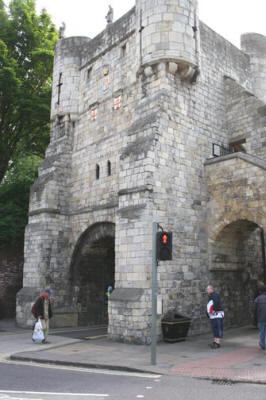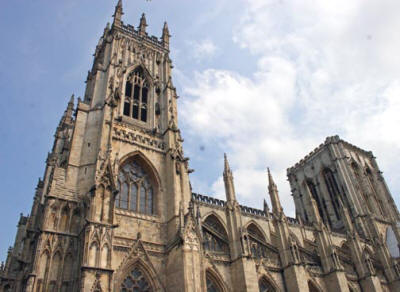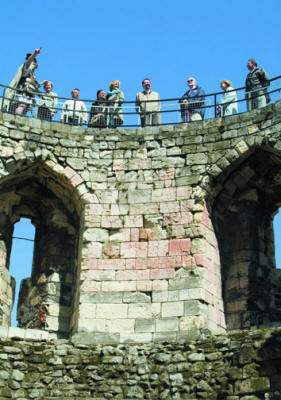|
Learn about York, England by reading Walk
Along the Ancient Wall-York, England by Sandy Zimmerman, Travel
Writer. It features a mini, but thorough tour of the destination,
plus all you'll need to know to plan your trip including getting
there, objective information on places to stay and eat, and things
to do. At the end of the article, we've provided a summary of the
contact information for your easy reference. Enjoy!
Walk Along the Ancient Wall-York, England
by Sandy Zimmerman, Travel Writer and WTA
Member

One of the gates in the wall as seen today.
Photo courtesy of Sandy Zimmerman
York, England is one of the world’s most exciting cities and
is proudly adorned with remnants of its past. This city was founded
in AD 71 by the Romans and they stayed until 410. History calls
this time the Dark Ages. It wasn’t known as York until around the
year 1000. The center of York is enclosed by the city's medieval
walls, still intact after over 1,900 years! We walked along this
World Heritage Site for hours and still did not see the entire wall.
Imagine the Roman legions patrolling these walls in the third century
AD. Known as the finest and most complete in England, the wall stretches
over two miles measuring 13’ high and 6’ wide. Perched high above
the city, it was an easy walk on cement sidewalks with many vantage
points along the way. The gateways through York’s defenses are called
gatehouses or “bars”. There are four main bars-Bootham Bar, Monk
Bar, Walmgate Bar and Micklegate Bar. These bars restricted traffic
in medieval times, were used to extract tolls, and for defensive
positions in times of war. Besides the four main bars, there are
two smaller bars-Fishergate Bar and Victoria Bar.

Part of the spectacular cathedral in York.
Photo courtesy of Sandy Zimmerman
York Minster (www.yorkminster.org),
which took over 250 years to complete, stands at the city's center
and is the second largest Gothic cathedral in Northern Europe (largest
is the Cologne Cathedral). It is the seat of the Archbishop of York,
which is the second-highest office of the Church of England and
its formal title is The Cathedral and Metropolitical Church of St
Peter in York. It contains the largest expanse of medieval stained
glass in the world.
The Shambles (www.britainexpress.com/cities/york/shambles.htm)
are narrow medieval streets, lined with shops, boutiques and tea
rooms. Most of these premises were once butchers' shops. The hooks
from which the meat was hung and the shelves on which it was laid
out can still be seen outside some of them. The street also contains
the Shrine of the Saint Margaret Clitherow, although it is not located
in the house where she lived. Margaret Clitherow (1556 - 1586) was
an English saint and martyr of the Roman Catholic Church. She was
arrested for the crime of harboring Roman Catholic priests and refused
to plead to the case. She was executed by being crushed to death
with an immense weight of rocks and stones.
The National Railway Museum (www.nrm.org.uk)
is situated just beyond the York station and is part of the British
National Museum of Science and Industry. It tells the story of rail
transport in Britain and its impact on society. It is home to the
largest collection of railway locomotives in the world and included
in this collection are the world's fastest steam locomotive - LNER
4468 Mallard and the world famous 4472 Flying Scotsman. Also on
the 20 acre site are hundreds of thousands of other items and records
of social, technical, artistic and historical interest, exhibited
mostly in three large halls near York railway station. It is the
largest museum of its type in the world.

A Roman re-enactor explains the importance
of the wall to visitors.
Photo courtesy of Sandy Zimmerman
Some of York’s other famous stops are the Castle Museum, Yorkshire
Museum and Gardens (www.yorkshiremuseum.org.uk), JORVIK Viking
Centre, York Art Gallery (www.yorkartgallery.org.uk), King Richard III
Visitor Centre (https://kriii.com),
the Merchant Adventurers' Hall (www.merchantshallyork.org),
the medieval house Barley Hall (http://barleyhall.co.uk),
Fairfax House (www.fairfaxhouse.co.uk),
the Treasurer's House, York Dungeon, York Boat Tour (www.citycruisesyork.com),
and more. You can ride the Hop-on Hop-off Tour Bus around the city.
From Medieval defense to Victorian promenade, York’s history
is filled with stories of the Romans, Vikings, and Normans, as well
as Medieval and Victorian times. We were amazed to see striking
changes in the buildings and streets from one section to another
representing the different eras. While strolling around the time
worn buildings, there were many shops, sidewalk cafes and museums
to attract our attention.
Don’t miss York’s Ghost Tours (www.ghosthunt.co.uk)
to haunted pubs, hotels, and everywhere ghosts hang out.
Events
We were happy to see one of the largest gatherings of sword
dancer events, the International Sword Spectacular.
With dancers from seven European countries, the US, and England,
the parades and demonstrations filled the streets. They were celebrating
ancient sword dancing with its European roots. The Spectacular’s
organizers invited the public to join one of the sword dance groups
with free tuition or try the beginner’s workshops. Sword dances
have been performed across Europe for 700 years.
Places to Eat
Chef-owner Chris Pragnell of Café no. 8 Bistro (www.cafeno8.co.uk),
says, “I care about my cooking and am my own critic. Ideas come
to me and I put my own creations together. People eat with their
eyes. The food has to look good. My dishes are influenced from the
world. I don’t want to be confined just to Yorkshire.” Chef Chris
offers interesting combinations like honey roasted home-smoked salmon,
North African spiced meat balls, and wild and chestnut mushroom
lasagna. We enjoyed dining outside on their patio. Most tourists
will be able to find Café no 8 as it is located at Gillygate, along
the wall, in York. Breakfast: 2.95- 6.95 pounds; Lunch: 8.95-10.95
pounds; Sandwiches: 5.95-8.95 pounds; Dinner: 13.95-16.95 pounds.
With a musical-themed setting of song sheets papering the walls,
Chef Ian Hancox, co-owner of the Café Concerto (www.cafeconcerto.biz),
describes his food as “music for your mouth.” Everything is different
about this Café. We sat at antique sewing machine tables, looked
at huge blackboards as menus, and listened to the music of Louie
Armstrong, Sarah Vaughan, and Ella Fitzgerald. Dinner became a very
pleasant interlude. It was a surprise to find Cajun-spiced swordfish,
Thai-style salad, Moroccan couscous, local Aberdeen Angus beef and
Gressinghan duck breast.
Customers can order a starter prepared into a larger portion
for their entrée or vice versa because Chef Ian wants everyone to
be happy. Concerto’s perfect location is inside the walls, in the
center of ancient York, opposite the Minster’s west door, by the
main stairway of Peter Gate. Deli Sandwiches: 6.75-7.95 pounds;
Platters: 8.95 pounds; Hot Lunches: 7.75-9.95 pounds; Salads: 8.95-9.75
pounds; Dinner: 8.95- 15.95 pounds with evening specials from 4.95
pounds; Children’s Menu: 2.25-4.25 pounds.
Tourist Information
York Tourist Information:
www.visityork.org.
York Visitor’s Pass - See the city including over 30 attractions
with discounts and special offers:
www.yorkpass.com
Entry Requirements
Americans must hold a valid passport; a visa is not required.
UK immigration officials decide on the length of stay up to six
months depending on the reason for travel.
Notice: This information is current as of
November 2008. It is recommended that you contact the numbers, and/or
visit the websites above to determine any changes to the information.
|